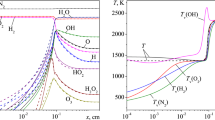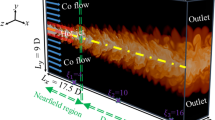Abstract
The presence of shocks in scramjet internal flows introduces nonequilibrium of internal energy modes of the molecules. Here, the effect of vibrational nonequilibrium on key reactions of hydrogen–air combustion is studied. A quasi-classical trajectory (QCT) approach is used to derive reaction probability for nonequilibrium conditions using ab initio-derived potential energy surfaces. The reaction rates under nonequilibrium are studied using a two-temperature description, where the vibrational modes are assumed to be distributed according to a Boltzmann distribution at a characteristic vibrational temperature, in addition to a translational temperature describing the translational and rotational population distribution. At scramjet-relevant conditions, it is found that the nonequilibrium reaction rate depends not only on the level of vibrational excitation, but also on the reactants involved. Conventional two-temperature models for reaction rates, often derived using empirical means, were found to be inaccurate under these conditions, and modified parameters are proposed based on the QCT calculations. It is also found that models that include details of the reaction process through dissociation energy, for instance, provide a better description of nonequilibrium effects.












Similar content being viewed by others
References
Chapuis, M., Fedina, E., Fureby, C., Hannemann, K., Karl, S., Martinez Schramm, J.: A computational study of the HyShot II combustor performance. Proc. Combust. Inst. 34(2), 2101–2109 (2013)
Martinez Schramm, J., Karl, S., Hannemann, K., Steelant, J.: Ground testing of the HyShot II scramjet configuration in HEG. In: 15th AIAA International Space Planes and Hypersonic Systems and Technologies Conference, AIAA Paper 2008-2547 (2008)
Koo, H., Raman, V., Varghese, P.L.: Direct numerical simulation of supersonic combustion with thermal nonequilibrium. Proc. Combust. Inst. 35(2), 2145–2153 (2015)
Reising, H.H., Utsav, K.C., Voelkel, S., Clemens, N.T., Raman, V., Varghese, P.L., Koo, H.: Vibrational non-equilibrium effects in supersonic jet mixing. In: 52nd Aerospace Sciences Meeting, AIAA Paper 2014-0231 (2014)
Candler, G.V., MacCormack, R.W.: Computation of weakly ionized hypersonic flows in thermochemical nonequilibrium. J. Thermophys. Heat Transf. 5(3), 266–273 (1991)
Park, C.: Review of chemical-kinetic problems of future NASA missions. I—Earth entries. J. Thermophys. Heat Transf. 7(3), 385–398 (1993)
Adamovich, I.V., Macheret, S.O., Rich, J.W., Treanor, C.E.: Vibrational relaxation and dissociation behind shock waves. Part 1—Kinetic rate models. AIAA J. 33(6), 1064–1069 (1995)
Popov, N.A.: The effect of nonequilibrium excitation on the ignition of hydrogen–oxygen mixtures. High Temp. 45(2), 261–279 (2007)
Knab, O., Fruehauf, H.H., Jonas, S.: Multiple temperature descriptions of reaction rate constants with regard to consistent chemical-vibrational coupling. In: 27th Thermophysics Conference, AIAA Paper 92-2947 (1992)
Knab, O., Fruehauf, H.H., Messerschmid, E.W.: Theory and validation of the physically consistent coupled vibration-chemistry-vibration model. J. Thermophys. Heat Transf. 9(2), 219–226 (1995)
Starik, A.M., Titova, N.S.: Kinetic mechanisms for the initiation of supersonic combustion of a hydrogen–air mixture behind a shock wave under the excitation of molecular vibrations in initial reagents. Tech. Phys. 46(8), 929–940 (2001)
Bernstein, R.B. (ed.): Atom-Molecule Collision Theory: A Guide for the Experimentalist. Plenum Press, New York (1979)
Levine, R.D., Berstein, R.B.: Molecular Reaction Dynamics and Chemical Reactivity. Oxford University Press, New York (1987)
Steinfeld, J.I., Francisco, J.S., Hase, W.L.: Chemical Kinetics and Dynamics, 2nd edn. Prentice Hall, Upper Saddle River (1999)
Bender, J.D., Valentini, P., Nompelis, I., Schwartzentruber, T.E., Candler, G.V.: Characterization of vibrational and rotational energy transfer in \(\text{ N }_{2} + \text{ N }_{2}\) dissociative collisions using the quasiclassical trajectory method. In: 45th AIAA Thermophysics Conference, AIAA Paper 2015-3253 (2015)
Hase, W.L., Duchovic, R.J., Hu, X., Komornicki, A., Lim, K.F., Lu, D.H., Peslherbe, G.H., Swamy, K.N., Linde, S.R.V., Varandas, A., Wang, H., Wolf, R.J.: VENUS96: a general chemical dynamics computer program. Quantum Chem. Progr. Exch. 16, 671 (1996)
Bender, J.D., Nompelis, I., Valentini, P., Doraiswamy, S., Schwartzentruber, T.E., Candler, G.V., Paukk, Y., Yang, K.R., Varga, Z., Truhlar, D.G.: Quasiclassical trajectory analysis of the \(\text{ N }_{2} + \text{ N }_{2}\) reaction using a new ab initio potential energy surface. In: 11th AIAA/ASME Joint Thermophysics and Heat Transfer Conference, AIAA Paper 2014-2964 (2014)
Xie, D., Xu, C., Ho, T.S., Rabitz, H., Lendvay, G., Lin, S.Y., Guo, H.: Global analytical potential energy surfaces for \(\text{ HO }_{2}\,(\widetilde{X}^2 \text{ A }^{\prime \prime } )\) based on high-level ab initio calculations. J. Chem. Phys. 126(7), 074315 (2007)
Xu, C., Xie, D., Zhang, D.H., Lin, S.Y., Guo, H.: A new ab initio potential-energy surface of \(\text{ HO }_{2}(X^2A^{\prime \prime })\) and quantum studies of \(\text{ HO }_{2}\) vibrational spectrum and rate constants for the \(\text{ H } \text{+ } \text{ O }_{2}\longleftrightarrow \text{ O } \text{+ } \text{ OH }\) reactions. J. Chem. Phys. 122(24), 244305 (2005)
Braunstein, M., Adler-Golden, S., Maiti, B., Schatz, G.C.: Quantum and classical studies of the \(\text{ O }(^3P) + \text{ H }_{2}(v=0-3, j=0) \longrightarrow \text{ OH } \text{+ } \text{ H }\) reaction using benchmark potential surfaces. J. Chem. Phys. 120(9), 4316 (2004)
Rogers, S., Wang, D., Kuppermann, A., Walch, S.: Chemically accurate ab initio potential energy surfaces for the lowest \(^3\text{ A }^\prime \) and \(^3\text{ A }^{\prime \prime }\) electronically adiabatic states of \(\text{ O }(^3P) + \text{ H }_{2}\). J. Phys. Chem. A 104(11), 2308–2325 (2000)
Brandão, J., Mogo, C., Silva, B.C.: Potential energy surface for \(\text{ H }_{2}\text{ O }(^3\text{ A }^{\prime \prime })\) from accurate ab initio data with inclusion of long-range interactions. J. Chem. Phys. 121(18), 8861 (2004)
Rashed, O., Brown, N.J.: A molecular dynamics study of the reaction \(\text{ H }_{2} + \text{ OH } \longrightarrow \text{ H }_{2}\text{ O } + \text{ H }\). J. Chem. Phys. 82(12), 5506 (1985)
Schatz, G.C., Elgersma, H.: A quasi-classical trajectory study of product vibrational distributions in the \(\text{ OH } + \text{ H }_{2} \longrightarrow \text{ H }_{2}\text{ O } \text{+ } \text{ H }\) reaction. Chemical Physics Letters 73(1), 21–25 (1980)
Voelkel, S.J., Raman, V., Varghese, P.L.: Quasi-state-specific QCT method for calculating the dissociation rate of nitrogen in thermal non-equilibrium. In: 54th AIAA Aerospace Sciences Meeting, AIAA Paper 2016-0449 (2016)
Millikan, R.C., White, D.R.: Systematics of vibrational relaxation. J. Chem. Phys. 39(12), 3209–3213 (1963)
Wang, Q., Moin, P., Iaccarino, G.: A high order multivariate approximation scheme for scattered data sets. J. Comput. Phys. 229(18), 6343–6361 (2010)
Acknowledgments
This work was supported by the AFOSR under Grant Number FA9550-12-1-0460 with Dr. Ivett Leyva as the grant monitor. The authors thank the Texas Advanced Computing Center (TACC) for their generous allocation of computing time, and the creators and distributors of the potential energy surfaces for their cooperation in this work.
Author information
Authors and Affiliations
Corresponding author
Additional information
Communicated by G. Ciccarelli.
This paper is based on work that was presented at the 25th International Colloquium on the Dynamics of Explosions and Reactive Systems, Leeds, UK, August 2–7, 2015.
Appendix: Uncertainty estimation
Appendix: Uncertainty estimation
The QCT algorithm, as implemented here, introduces two different sources of numerical uncertainty: (1) the finite number of trajectories (or samples) used to compute the reaction rates for each translational speed, rotational temperature, and vibrational temperature, and (2) the interpolation of these reaction rates over the \(T-T_v\) space, which is needed for the evaluation of the efficiency function. The first error is associated with the Monte Carlo sampling procedure, while the second arises from the interpolation of uncertain variables.
To quantify the error in the reaction probability estimation for a given set of input variables, the uncertainty of the multi-reaction rate was calculated alongside the rate, which corresponds to a 95 % confidence interval (two standard deviations from the mean). Based on the formulation of the Monte Carlo sampling technique, for sufficiently large N, the uncertainty of the probability of the reaction is given by
Because all of the operators used to calculate the rate based on \(P_r\) are linear, it follows that the uncertainty in the reaction rate can be calculated by substituting \(\delta P_r\) in the place of \(P_r\) in (3) and the subsequent equations. The resulting uncertainty of the multi-temperature reaction rate, \(\delta k_r(T,{\varvec{T}}_v)\), was checked throughout the simulation to ensure a high level of convergence of the results.
In order to obtain the efficiency function for all \(T-T_v\) values, these rates determined at a few sample locations need to be interpolated. The uncertainty estimate given above in (13) was used in this interpolation technique as well. For this purpose, the multivariate interpolation and regression (MIR) scheme proposed by Wang et al. was used [27]. The scheme creates a high-order approximation function constructed from a set of data points on a scattered domain where the estimate of the approximation error at each data point is minimized. The set of data points used to create the interpolant were given by
for \(i = 1, \ldots , N_x\) and \(N_x\) is the number of rates directly calculated.
The uncertainty in the numerical estimation of the reaction probability was calculated using (13) and used to calculate the uncertainty in the reaction rate \(\delta k_r\), as discussed in Sect. 1. This uncertainty corresponds to a 95 % confidence interval, or 2 standard deviations from the expected value. Then, a set of input data points with their corresponding uncertainty were created for interpolation using (14) and (15), denoted as vectors by \({\varvec{\delta }\varvec{x}}\) and \({\varvec{x}}\). Table 3 shows the RMS and maximum uncertainty of each reaction. It is seen that the overall uncertainty in the rate estimation using Monte Carlo sampling is low.
Based on the algorithm in Ref. [27], the interpolant was created from 20 Taylor expansion terms and a polynomial exactness factor of 2. The interpolant was used to calculate the rate versus T and \(T_v\) ranging from 400 to 2600 K with a grid spacing of 20 K. The approximated uncertainty of the interpolated data points is shown in Table 4. Due to the linear nature of the input data set (i.e., the reaction rate varies logarithmically with T), the estimated uncertainty of the interpolated rates is small. Although the RMS values increased significantly compared to the uncertainties of the input data (see Table 3), they are still small in comparison to the mean absolute rates. These calculations demonstrate that both the sampling procedure and the interpolated values contain low numerical error.
Rights and permissions
About this article
Cite this article
Voelkel, S., Raman, V. & Varghese, P.L. Effect of thermal nonequilibrium on reactions in hydrogen combustion. Shock Waves 26, 539–549 (2016). https://doi.org/10.1007/s00193-016-0645-0
Received:
Revised:
Accepted:
Published:
Issue Date:
DOI: https://doi.org/10.1007/s00193-016-0645-0




